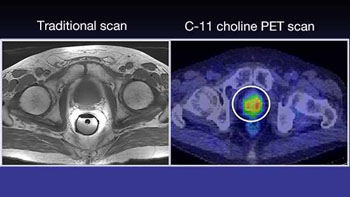PET Agent and Multi-Parametric MRI Help Find Cancer Recurrence Sites
By MedImaging International staff writers
Posted on 11 Oct 2016
Researchers have successfully used C-11 Choline Positron Emission Tomography (PET) imaging and multi-parametric Magnetic Resonance Imaging (MRI) to map prostate cancer recurrence after surgery.Posted on 11 Oct 2016
The technique enabled the researchers to find a range of anatomically different recurrence patterns that may be able to help clinicians optimize treatment of patients with prostate cancer recurrence after surgery. Two-thirds of patients have cancer recurrence only in the pelvis, and this could conceivably be treated using radiation therapy.

Image: A comparison of a traditional scan and a C-11 Choline Positron Emission Tomography (PET) imaging scan for the detection of prostate cancer recurrence sites (Photo courtesy of the Mayo Clinic).
The results of the research were published online in the July 20, 2016, issue of the Journal of Urology. According to the researchers at the Mayo Clinic (Rochester, MN, USA), a non-profit organization, around 30% of prostate cancer patients in the U.S. who have their cancer removed surgically, suffer recurrence of the disease. Conventional Computed Tomography (CT), and bone scans are sometimes not sensitive enough to reveal the cancer recurrence sites, when the Prostate-Specific Antigen (PSA) test results value is less than 10.
The researchers found that by using a combination of multi-parametric MRI, together with C-11 choline PET scanning, clinicians could identify recurrence sites accurately, even with an average PSA value of 2.
Jeffrey Karnes, MD, urological surgeon, Mayo Clinic, said, “This study has important implications for men who have a rising prostate-specific antigen (PSA) test, also known as biochemical recurrence, after radical prostatectomy for prostate cancer. In men with biochemical recurrence, determining where the disease has recurred is quite challenging, especially when the PSA level is low. This type of staging allows us to identify sites of recurrent disease that can be potentially treated either surgically or with radiation.”
Related Links:
Mayo Clinic














